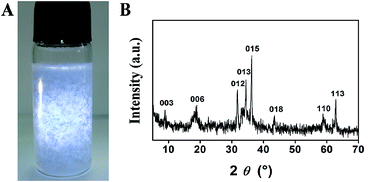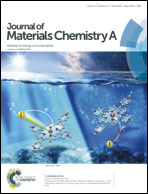One-step synthesis of zinc–cobalt layered double hydroxide (Zn–Co-LDH) nanosheets for high-efficiency oxygen evolution reaction†
Abstract
Two-dimensional (2D) nanomaterials show great potential for electrocatalysis or other applications that require large surface area. In this work, we developed porous zinc–cobalt layered double hydroxide (Zn–Co-LDH) nanosheets by using a one-step microwave-assisted approach, and examine their oxygen evolution reaction (OER) performance. The Zn–Co-LDH nanosheets with a high specific surface area of 116.4 m2 g−1 exhibit good OER activity, expressed as low onset overpotential, small Tafel slope and large exchange current density. At the overpotential of 0.54 V, the current density of Zn–Co-LDH nanosheets is about 15.06 mA cm−2, which is much higher than that of Zn–Co-LDH nanoparticles. The comparable electrocatalytic performance may be attributed to the porous 2D structure generating more active sites and higher electronic conductivity. Furthermore, the obtained Zn–Co-LDH nanosheets show good stability during long time running at 1.55 V vs. RHE. Accordingly, an effective OER catalyst is exploited by using a simple microwave-assisted synthesis. Such an effective method could be extended to large-scale synthesis of uniform and stable 2D LDH nanomaterials.


 Please wait while we load your content...
Please wait while we load your content...